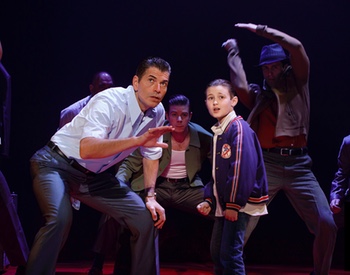Dear Evan Hansen @ Playhouse Square, June 11--June 30, 2019
Review by Laura Kennelly
Directed by Michael Greif, with book by Steven Levenson, a score by Benj Pasek and Justin Paul, the musical explores alienation, family dynamics, and chance. Greif, surely a master of unhappiness, offers a sad and serious look at life for several teens and two sets of parents. It should come as no surprise to learn that he also directed Rent and Next to Normal. The characters, the sub-text (modern life can be pretty awful, but there’s hope for us all), echoes a similar perspective.
The first and most important teen is, of course, Evan Hansen (Ben Levi Ross), a lonely kid with good intentions. Ross projects, with cringe-inducing accuracy, the painful shyness and insecurity his character suffers. It’s easy to identify. It’s also easy to identify with his mother Heidi Hansen (Jessica Phillips). Phillips subtily shows Heidi’s unintentional contributions to Evan’s problems by exhibiting mannerisms similar to her son’s. (Maybe it’s just me, but what teen has ever, ever in the history of teendom, ever answered truthfully the first time a parent asks “What’s bothering you?” Maybe some do.)
The Murphy family (as opposed to Evan’s single mom family) seems to have it all, but as nuanced performances by Larry Murphy (Aaron Lazar), Cynthia Murphy (Christiane Noll), and their children Zoe Murphy (played by understudy Ciara Alyse Harris), and Connor Murphy (Marrick Smith) reveal, that’s not true.That tragedy ultimately brings them together reflects the play’s ironic core.
Jared Goldsmith plays Evan’s kinda friend (Jared Kleinman) with delightfully creepy intensity. Phoebe Koyare, as the bossy Alana Beck, evokes memories of certain high school friends--the ones who always “had a great plan” and could tell you exactly what to do.
Technically, it’s a musical, but the music seems incidental; it’s mostly anthems of one sort of another that support the plot line. The most hummable include “Waving Through a Window” and “You Will Be Found,”
The scenic design by David Korins, with projection design by Peter Nigrini, brilliantly reflects our internet age. The stage, filled with flashing displays on vertical columns recreates life on Facebook or Twitter or on email. As the story progresses it echoes what’s happening on stage as digital life reflects “real” life. (I’ve got to add that the usual before-show warning to “Turn off your phones” was the most effective I’ve ever seen.) A usually invisible small orchestra, seated on a platform above the stage, was directed by Austin Cook.
Bottom Line: Dear Evan Hansen is well-produced technically and well-worth seeing. But for a story about redemption, it’s less persuasive than I’d hoped. More a play with incidental music than a “musical,” it lacks the tunes and self-awareness that, for example, a production dwelling on similar teen problems, Be More Chill, delights in.
Side Note: Playhouse Square offers a digital lottery for the few remaining tickets to Dear Evan Hansen at http://www.playhousesquare.org/news/detail/dear-evan-hansen-2019 [http://www.playhousesquare.org/news/detail/dear-evan -hansen-2019].






